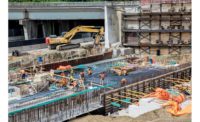Worried your project might be faced with a 100-year flood event? Or that rising sea levels could wind up flooding the ground level of the new office building you are slated to construct?
With climate change a growing factor in the local, state and federal permitting of projects, Massachusetts environmental officials have launched a new online climate change planning tool.
The new online platform is named Resilient MA Action Team Climate Resilience Design Standards Tool.
While designed with municipal planners in mind, the tool, currently being tested in beta form, is free for use by the public, including contractors and developers.
Local officials, for their part, can use the online climate resilience planning tool to assess multiple sites for potential infrastructure projects and other public construction, as well as to help bolster applications for state infrastructure funds.
State officials hope to have the final version in place by the end of the year, and are now seeking comments from local officials, developers and contractors who have given the online platform a whirl.
The online tool can be used to assess everything from new roads and bridges to buildings.
“It’s meant to be a planning tool and a preliminary climate risk flagger,” said Mia Mansfield, director of climate adaptation and resilience at Massachusetts Executive Office of Energy and Environmental Affairs.
The site itself is easy to use, with roughly 10 minutes needed to fill in the various information on the project need in order to get a climate risk assessment back, according to Mansfield.
The registration process requires just picking a user name and creating a password.
To get the review process started, the user is required to give the project a name and then locate the site of the project on the map – either through an address or by zooming in on a map of the state down to the street and lot level.
The next step is click on a drawing tool and identify the specific site by drawing a polygon around it.
After that, users are prompted to type in key data about the project, such as its location, it’s expected lifespan, its cost and its purpose.
Other questions cover whether the site has previously experienced flooding, and what type, whether it was coastal flooding, a result of extreme precipitation, or from a nearby river overflowing its banks.
Users are also questioned whether their project will lead to a “net increase of the impervious area of the site,” or pavement, or whether trees are being removed.
The online climate resilience assessment platform also asks whether the project will provide any “ecosystem benefits,” such as ground water recharge or storm damage mitigation, or if it is located within an “environmental justice community or provides services to vulnerable.”
Overall, the questions, a few dozen at most, are divided into six parts, after which the user can hit submit and then get back feedback on the level of risk it may face in future years and decades from climate change, from rising rivers and oceans to extreme heat.
Along with a risk assessment, the online tool will also make recommendations on what the community or developer and the contractor doing the work can do to make the project more resilient, whether it’s building a sea wall or putting sensitive mechanicals or other equipment on a higher floor to protect against flooding.
“It provides an exposure rating and recommendations on how to increase resilience,” Mansfield said.
The concept behind the new online platform won a thumbs up from Greg Vasil, CEO of the Greater Boston Real Estate Board.
Vasil said the online tool could potentially help the “regulatory process along” by helping cities and towns a “standard” to work by when it comes to assessing a project’s resilience when it comes to climate change.
“It’s another tool for cities and towns – it’s an issue cities and towns are already starting to look at anyway,” Vasil said.






Post a comment to this article
Report Abusive Comment